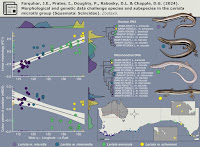 |
Protemnodon viator
Kerr, Camens, van Zoelen, Worthy & Prideaux, 2024
|
Abstract
Species of the kangaroo genus Protemnodon were common members of late Cenozoic communities across Australia and New Guinea until their extinction in the late Pleistocene. However, since the genus was first raised 150 years ago, it has proven difficult to diagnose, as have the species allocated to it. This is due primarily to the incompleteness of the type material and a heavy reliance on cheek tooth size and slight variations in premolar form. Along with the rare association between cranial and postcranial material, this has hampered understanding of the palaeobiology of these large-bodied kangaroos. Here we review and re-diagnose Protemnodon, recognising a total of seven species and providing a hypothesis of species interrelationships. The following new synonymies are made: Protemnodon chinchillaensis is synonymised with P. otibandus and P. hopei with P. tumbuna. The following are considered nomina dubia: Protemnodon brehus, P. roechus, P. mimas, P. antaeus, and P. devisi. We reveal that the morphology of the cheek dentition is not as consistently useful for differentiating species of Protemnodon as features of the cranium and postcranial skeleton. As a whole, the species share anatomical features that reflect stability and power in the limb joints, yet they differ in body proportions, and axial and limb morphology. This we interpret as showing locomotory adaptations to different habitats. Of the three Pliocene species, Protemnodon snewini is interpreted as a medium- to high-geared hopper, suggesting proficiency in more open environments, whereas P. dawsonae sp. nov. we infer to have been a medium-geared inhabitant of eastern Australian forests and woodlands. Protemnodon otibandus, with a range extending through the woodlands and forests of eastern Australia into the rainforests of eastern New Guinea, displays adaptations to slower hopping. Its Pleistocene descendant, P. tumbuna, is convergent on the morphology of modern New Guinea forest wallabies, and was likely facultatively quadrupedal. Of the three Australian Pleistocene species, the long-necked P. anak is hypothesised to have been a large, medium-geared, eastern Australian species, and P. mamkurra sp. nov. a robust, low-geared resident of well-wooded southern Australia habitats. By contrast, P. viator sp. nov. was larger but more gracile, suggested to be a medium- to high-geared species convergent in some traits on large extant kangaroos. This and a wide inland distribution point to adeptness in open, arid environments. Protemnodon mamkurra sp. nov. and P. viator sp. nov. occupy the morphospace previously occupied by P. roechus and P. brehus. Overall, the species of Protemnodon exhibit a degree of ecomorphological variation suggestive of a broader array of ecological adaptations than hitherto envisioned.
Australia, New Guinea, Biogeography, Pliocene, Pleistocene, morphology, adaptation, Megafauna, taxonomy, Mammalia
 |
| Australian artist Peter Schouten’s reconstruction of the extinct kangaroos Protemnodon anak (upper) and Protemnodon tumbuna (lower). Despite being closely related, the two were quite different animals in terms of their habitat and their method of hopping. |
 |
| A near-complete fossil skeleton of the extinct giant kangaroo Protemnodon viator from Lake Callabonna, missing just a few bones from the hand, foot and tail. |
 |
| Artist Peter Schouten’s impression of south-eastern South Australia during the Pleistocene (~500 thousand years ago) showing many of the plants and animals that lived there alongside Protemnodon. |
Isaac A.R. Kerr, Aaron B. Camens, Jacob D. van Zoelen, Trevor H. Worthy and Gavin J. Prideaux. 2024. Systematics and Palaeobiology of Kangaroos of the late Cenozoic Genus
Protemnodon (Marsupialia, Macropodidae).
Megataxa. 11(1); 1-261. DOI:
10.11646/megataxa.11.1.1
Giant kangaroos bounce back from the past














































